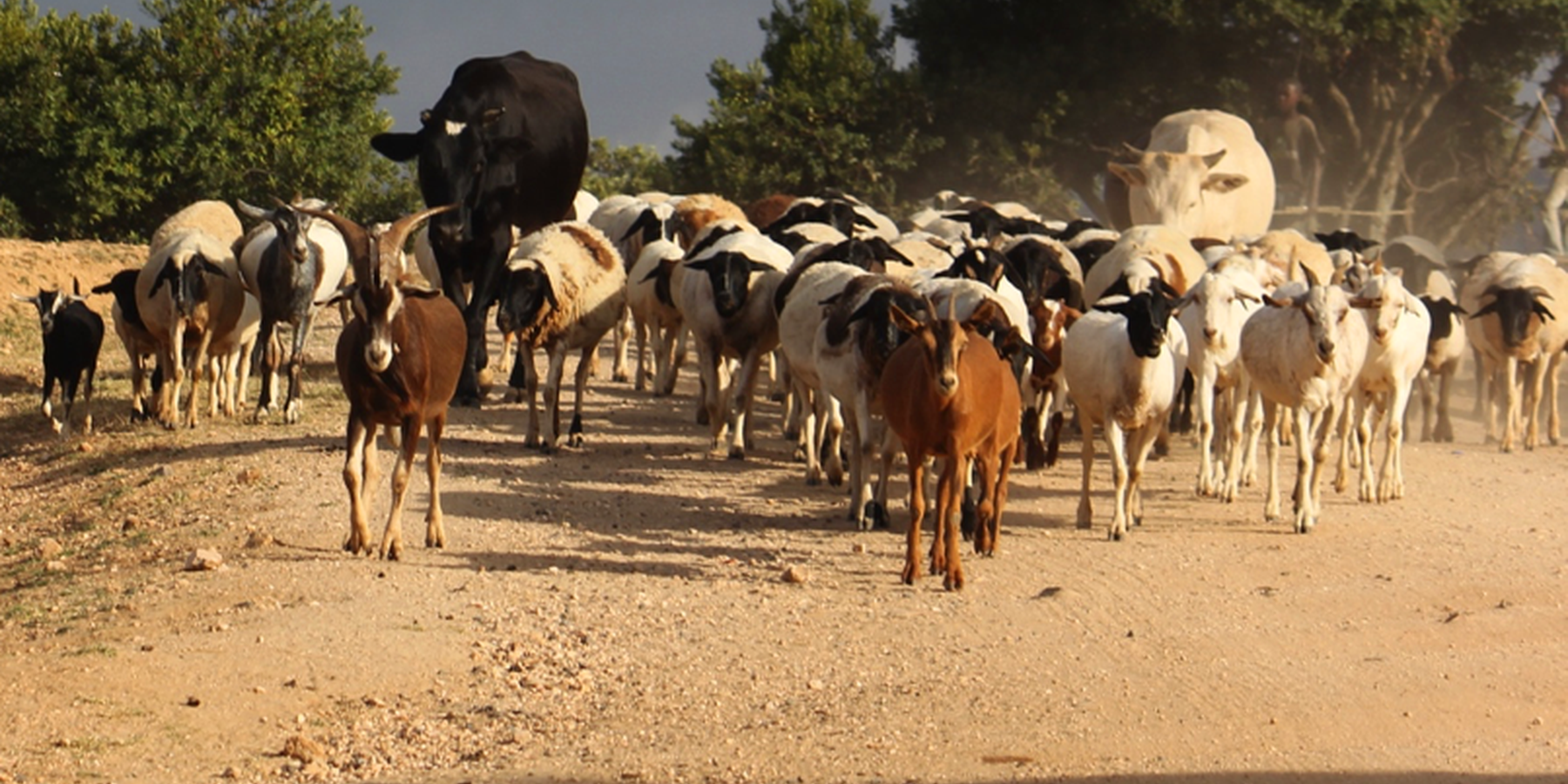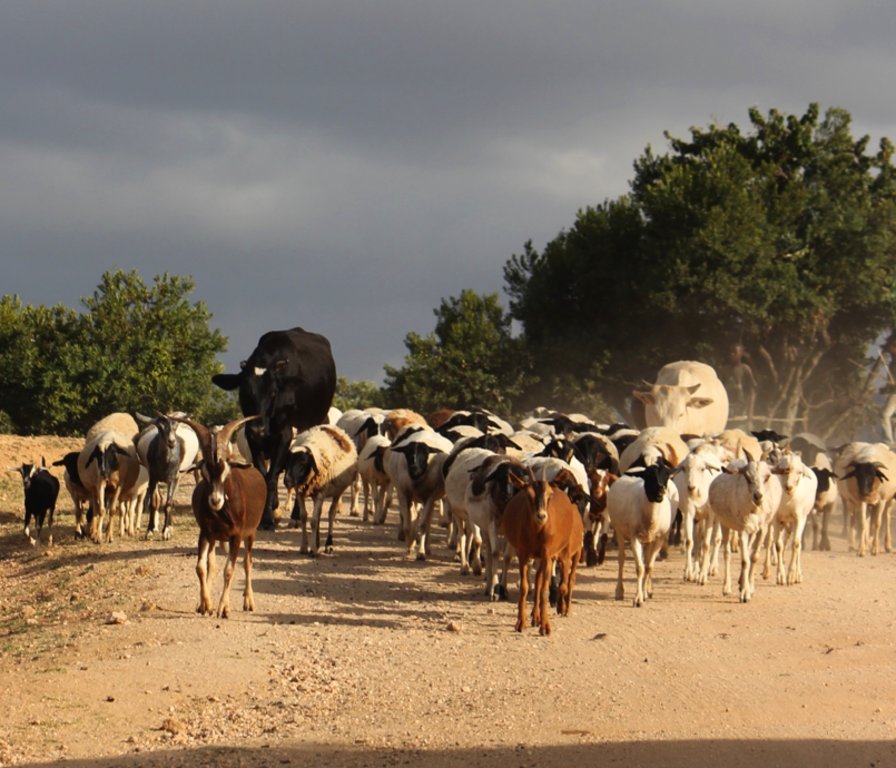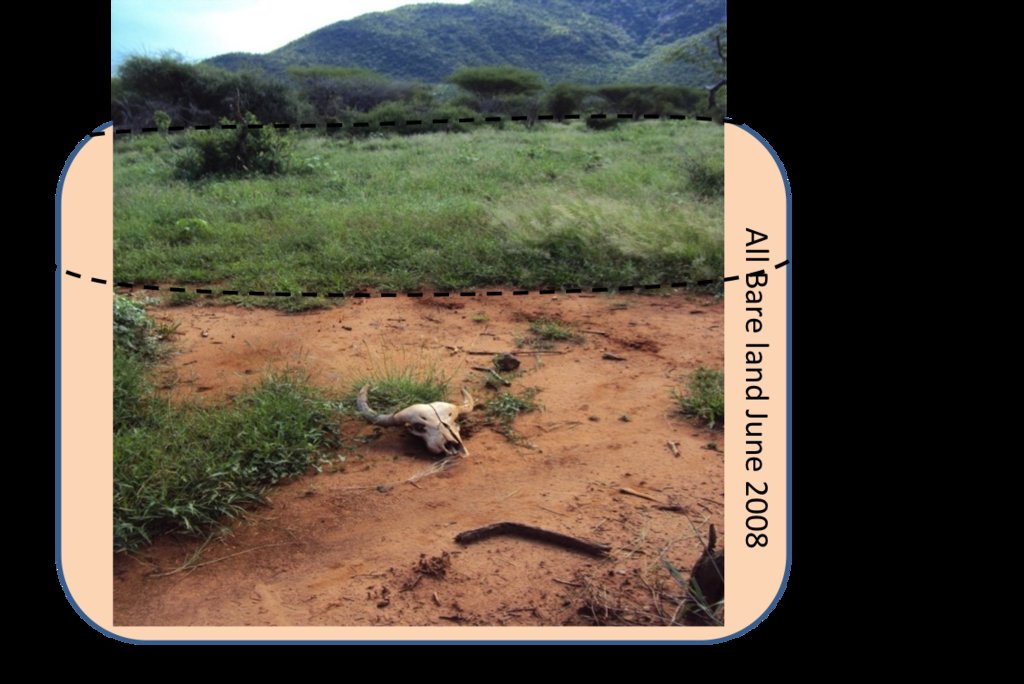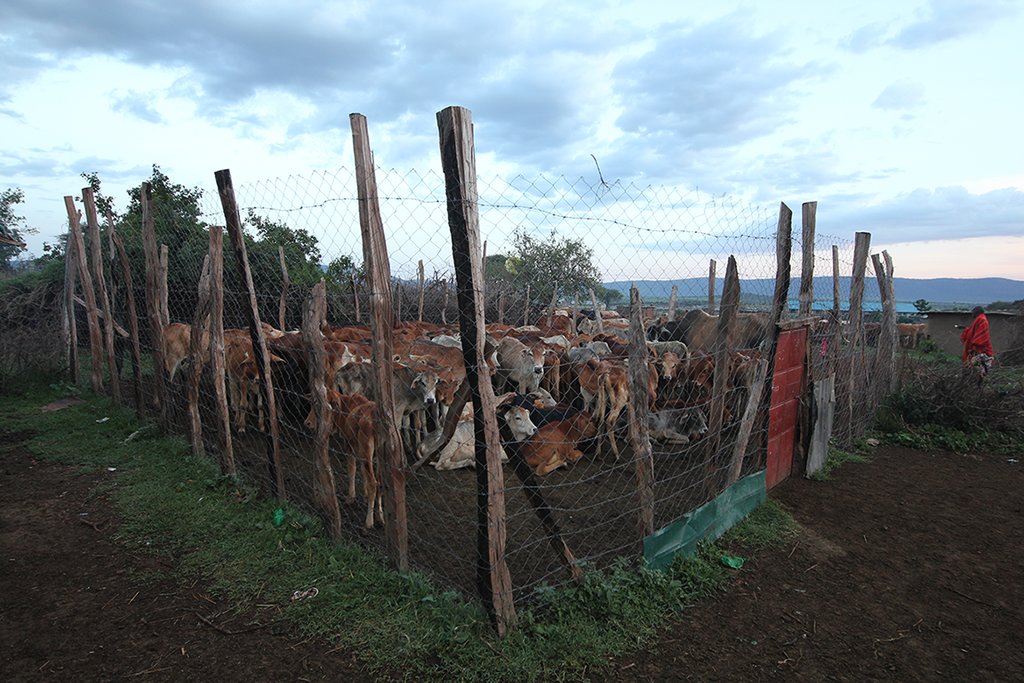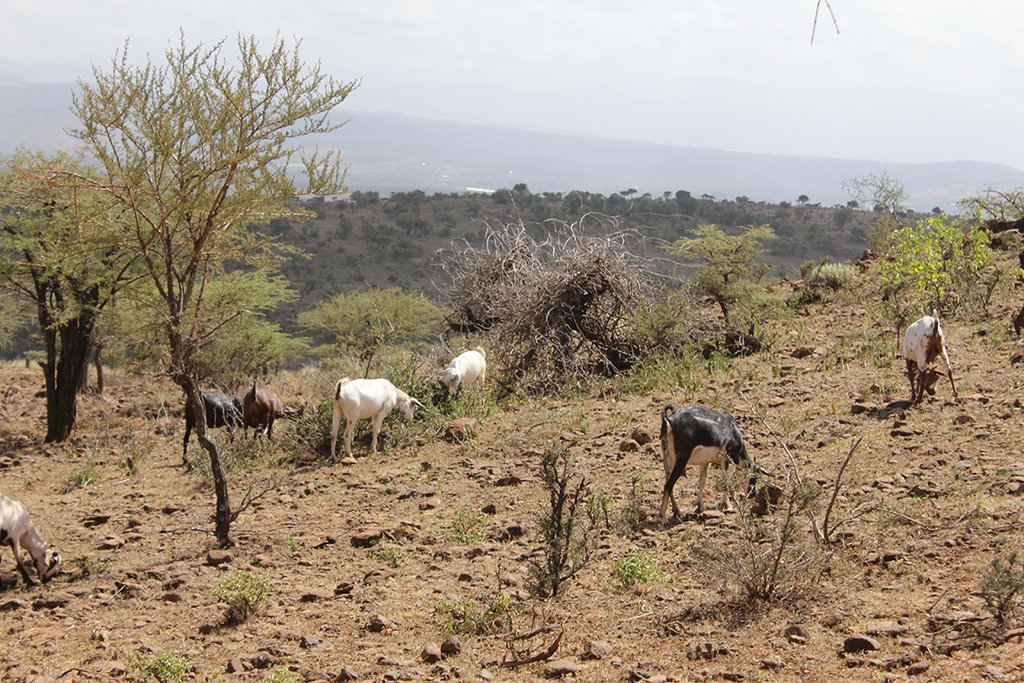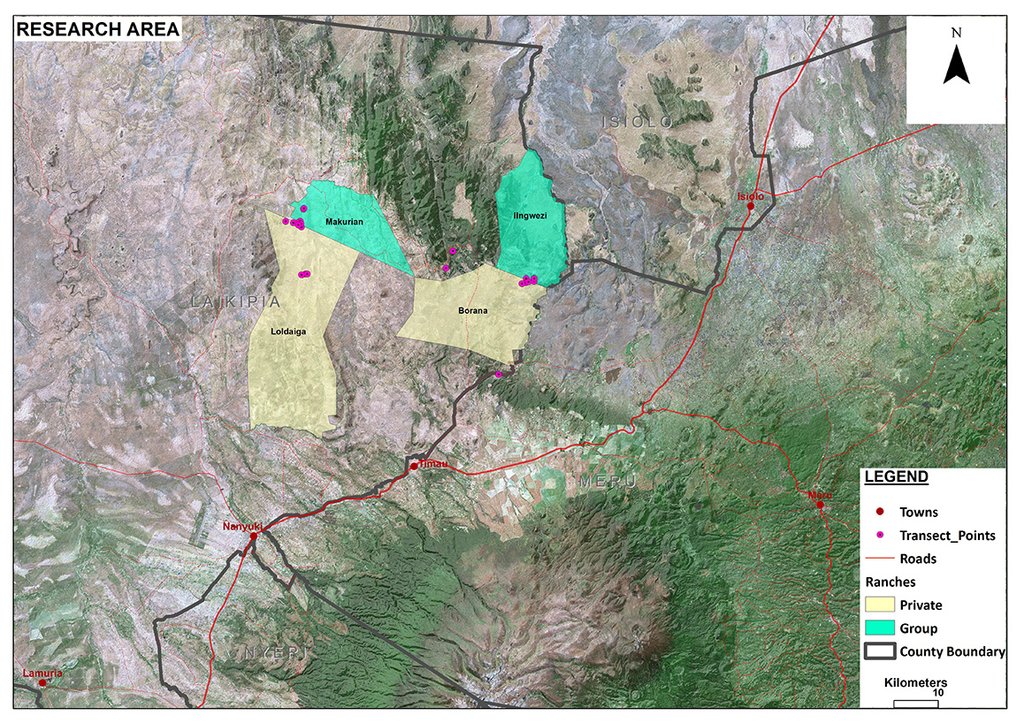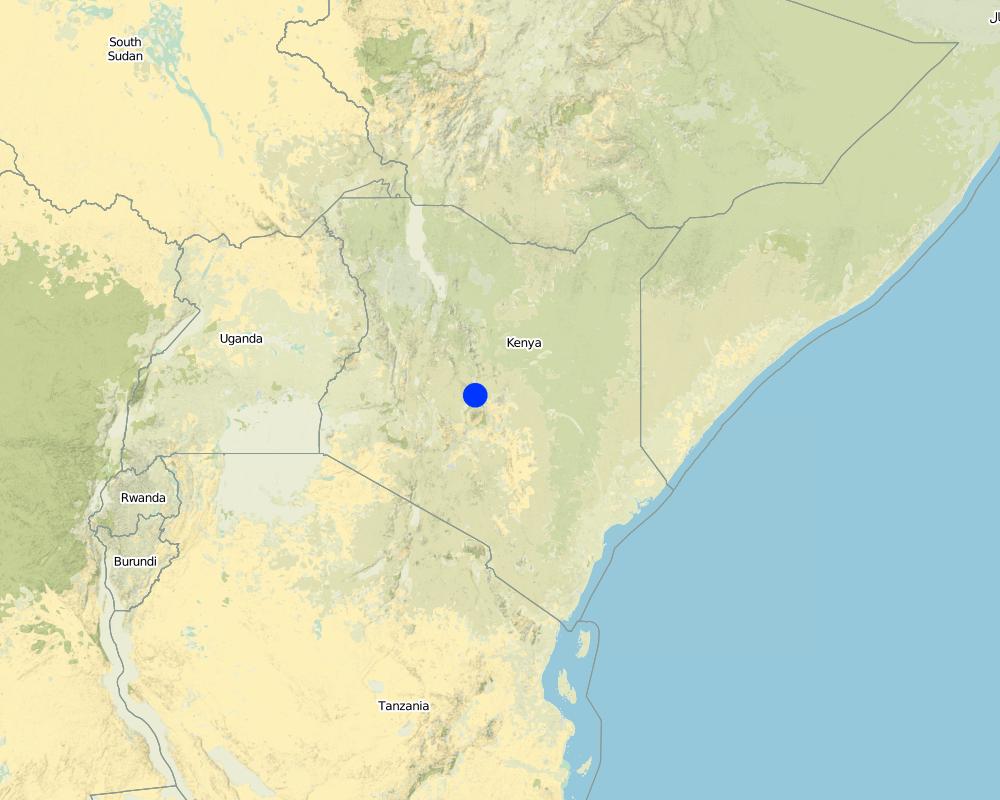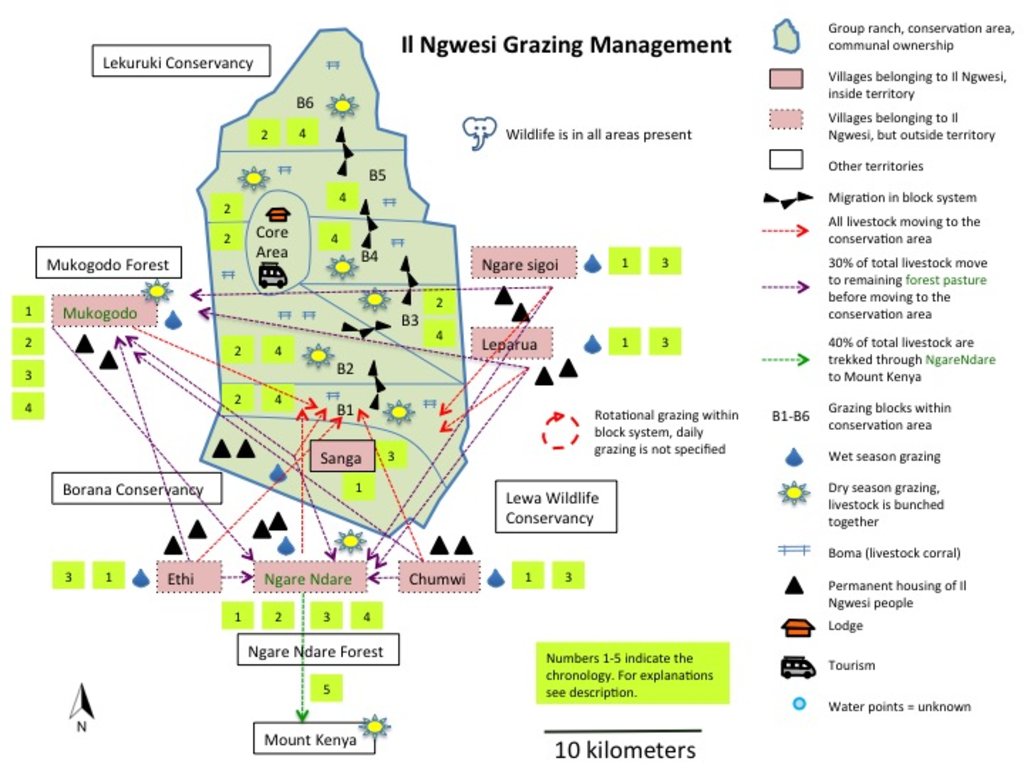Il Ngwesi Group Ranch Grazing with Holistic Management Principles [Kenya]
- Création :
- Mise à jour :
- Compilateur : Michael Herger
- Rédacteur : –
- Examinateurs : Rima Mekdaschi Studer, Alexandra Gavilano
technologies_2092 - Kenya
- Résumé complet en PDF
- Résumé complet en PDF pour impression
- Résumé complet dans le navigateur
- Résumé complet (non formaté)
- Pâturage selon des principes holistiques sur le ranch collectif de Il Ngwesi: 4 septembre 2019 (inactive)
- Il Ngwesi Group Ranch Grazing with Holistic Management Principles: 22 février 2018 (inactive)
- Pâturage selon des principes holistiques sur le ranch collectif de Il Ngwesi: 11 juillet 2018 (inactive)
- Pâturage selon des principes holistiques sur le ranch collectif de Il Ngwesi: 3 septembre 2018 (inactive)
- Pâturage selon des principes holistiques sur le ranch collectif de Il Ngwesi: 4 octobre 2018 (inactive)
- Pâturage selon des principes holistiques sur le ranch collectif de Il Ngwesi: 2 novembre 2021 (inactive)
- Pâturage selon des principes holistiques sur le ranch collectif de Il Ngwesi: 2 novembre 2021 (public)
- Il Ngwesi Group Ranch Grazing with Holistic Management Principles: 1 février 2018 (inactive)
Voir les sections
Développer tout Réduire tout1. Informations générales
1.2 Coordonnées des personnes-ressources et des institutions impliquées dans l'évaluation et la documentation de la Technologie
Personne(s)-ressource(s) clé(s)
exploitant des terres:
Leresi Patrick
+254721153572
ilngwesi@nrt-kenya.org
Il Ngwesi Group Ranch
Mukogodo Division, Laikipia North District, PO Box 263, 1042 Timau, Kenya
Kenya
1.3 Conditions relatives à l'utilisation par WOCAT des données documentées
Quand les données ont-elles été compilées (sur le terrain)?
22/01/2017
Le compilateur et la(les) personne(s) ressource(s) acceptent les conditions relatives à l'utilisation par WOCAT des données documentées:
Oui
1.4 Déclaration sur la durabilité de la Technologie décrite
Est-ce que la Technologie décrite ici pose problème par rapport à la dégradation des terres, de telle sorte qu'elle ne peut pas être déclarée comme étant une technologie de gestion durable des terres?
Non
Commentaires:
Yes and no, only time will tell here.
Grazing principles and management (with partly applied Holistic Managment) of Il Ngwesi Group Ranch are said to be exemplary for group ranches in the area. In evaluation processes since the introduction of the new principles and also in reports, they were rated as "best practice". Land recovery is according to these reports in full swing. However, in the field the picture looks partially different. The land is in large areas (still) heavily degraded. Data suggests that vegetation and soil is in a rather bad condition - many erosion features characterize the land. Nevertheless, according to land users, land coverage has significantly improved since the introduction of the new technologies.
2. Description de la Technologie de GDT
2.1 Courte description de la Technologie
Définition de la Technologie:
A group ranch belonging to the Masai (traditionally, nomad pastoralists) has applied "Holistic Management" grazing principles. The principles consist of separate, planned grazing in villages during the rains, then “bunching” and moving of all animals in herds during the dry season. Denuded land is recovered by a "Boma” technology: i.e. strategic corralling of animals overnight, and reseeding.
2.2 Description détaillée de la Technologie
Description:
On Il Ngwesi Masai Group Ranch, livestock production management is a combination of traditional livestock keeping and holistic grazing management principles which were introduced in 2007. Livestock production at Il Ngwesi is for subsistence and sales - and has very high cultural significance. 80% of the land is used for conservation, where wildlife and their habitat are protected. The vision is to integrate community development and sustainable environmental management.
Holistic Management (HM) was originally conceived by Allan Savory (1988), and is facilitated by the Laikipia Wildlife Forum. It integrates decision-making, planning, and livestock keeping. On the land, this means bunching of all livestock close together (in order to act as a "bulldozer" and break the soil to allow seeds, nutrients, and water to infiltrate) resulting in better plant growth. By moving the animals together from block to block, HM aims at managing high numbers of livestock while restoring degraded land. Instead of individual livestock-owning families herding and trekking their own animals, consolidated herds are now managed and moved together, and overseen by herders and supervisors. This allows intensive grazing in restricted areas while resting the remaining land - instead of continuous open grazing. However, Holistic Management principles are still a matter of controversy.
The group ranch land consists of a settlement and a conservation area. The conservation area is further subdivided into a small core zone, measuring 500 hectares and a larger buffer zone of 6,000 hectares. Within this buffer zone, pastoralists are permitted to graze livestock during the dry season.
Besides these two main grazing areas in their group ranch, they use additional grazing areas outside their territory such as pasture in forests. In one forest - Mukogodo - they have settled officially; in Ngare Ngare and on Mount Kenya, on the other hand, it is more of an informal agreement. In Il Ngwesi, HM principles are very strictly applied in the conservation area; elsewhere only partly or not at all. During the movements to the forest glades and Mount Kenya, HM principles are maintained as far as possible.
This documentation describes the combined grazing management system. During the rains, the grazing system is largely by traditional management: animals remain in and around villages managed individually by households. During the dry season, all livestock are bunched together and managed as one herd.
During the wet season, grazing at Il Ngwesi Group Ranch is organized by elders within their seven villages. HM principles are only partly applied. During the dry season, once all the grazing land is eaten, livestock are bunched together and managed by a few herders and overseers. The block system rotation starts. To seek new pasture and water, cattle and smallstock are led to forest glades, and then to the Il Ngwesi conservation area. As soon as the forest pasture is gone, they move on to the conservation area. Usually, this movement of livestock to forests and conservation area starts in February; then they return to the villages in April; and then back to the forests and conservation area until the next rains in November.
Whilst the livestock are bunched together, large bomas (corrals in Kiswahili) are constructed for overnight enclosure. Bomas are sited on bare land where dung accumulation and crust breaking by hooves helps rehabilitate land. Every year the boma sites are shifted slightly according to a plan. The total area that can be restored per year is almost 1% of the area of Il Ngwesi.
2.3 Photos de la Technologie
2.5 Pays/ région/ lieux où la Technologie a été appliquée et qui sont couverts par cette évaluation
Pays:
Kenya
Région/ Etat/ Province:
Laikipia
Autres spécifications du lieu:
Mukogodo Divison
Map
×2.6 Date de mise en œuvre de la Technologie
Indiquez l'année de mise en œuvre:
2007
2.7 Introduction de la Technologie
Spécifiez comment la Technologie a été introduite: :
- dans le cadre d'un système traditionnel (> 50 ans)
- par le biais de projets/ d'interventions extérieures
Commentaires (type de projet, etc.) :
Holistic Management approach by Allan Savory.
In Laikipia, it was introduced by Richard Hartfield, Laikipia Wildlife Forum and funded by Laikipia Wildlife Forum (LWF), Lewa Conservancy and Northern Rangeland Trust (NRT) (approximately 50% of all additional costs of Il Ngwesi since the implementation were covered by funding). Agreement with elders was reached first, then the community was trained.
3. Classification de la Technologie de GDT
3.1 Principal(aux) objectif(s) de la Technologie
- améliorer la production
- réduire, prévenir, restaurer les terres dégradées
- préserver l'écosystème
- conserver/ améliorer la biodiversité
3.2 Type(s) actuel(s) d'utilisation des terres, là où la Technologie est appliquée

Pâturages
Pâturage extensif:
- Semi-nomadisme/ pastoralisme
Principales espèces animales et principaux produits:
Livestock: Cattle, goats, sheep, donkeys, camels
Meat and milk production (also blood) and as a bank/ value asset. Mainly subsistence and local production.
Livestock: 4’800 TLU; Stocking rate: 3.3 ha/TLU (calculated with the total affected land by livestock: 157km2)
Pressure on land including wildlife: 3.3 ha/TLU (stays the same, calculated with wildlife biomass density estimated by Georgiadis et al. 2007).
Livestock numbers:
Lower Il Ngwesi: 4000 cattle, 20'000 shoats, 50 donkeys, 100 camels.
Sanga: 700 cattle, 2000 shoats, 20 donkeys.
Mukogodo: 1500 cattle, 5000 shoats, 20 donkeys
Livestock fluctuations (per year): -10% sales, -5% loss due to drought/diseases, -5% slaughtered,
+30% natural breeding, new purchase and deaths are mutually offsetting.
Steers are for fattening on private ranches and during droughts other livestock can be moved to private ranches (up to 3000).
Wildlife: elephant, antelope/ gazelle (like gerenuk, impala, Thomson's gazelle, dik-dik), hares, predators and more.

Implantations, infrastructures
- Habitats, buildings
Remarques:
Villages, bomas, manyattas.
8'000 inhabitans.
Lodge for Tourism.
3.3 Informations complémentaires sur l'utilisation des terres
Approvisionnement en eau des terres sur lesquelles est appliquée la Technologie:
- pluvial
Nombre de période de croissance par an: :
- 2
Précisez:
Short rains in November and December. Long rains in April and May. Rains from (October) November to December are usually better in this area. Rainfalls with strong local variations and changing regimes.
Densité d'élevage/ chargement (si pertinent):
4’800 TLU; Stocking rate: 3.3 ha/TLU. Pressure on land: 3.3 ha/TLU
3.4 Groupe de GDT auquel appartient la Technologie
- pastoralisme et gestion des pâturages
- Amélioration de la couverture végétale/ du sol
3.5 Diffusion de la Technologie
Spécifiez la diffusion de la Technologie:
- répartie uniformément sur une zone
Si la Technologie est uniformément répartie sur une zone, indiquez la superficie couverte approximative:
- 10-100 km2
Commentaires:
Il Ngwesi has an area size of 87 km2. However, the total affected land by livestock is 157km2. The technology is also applied on other ranches (mainly private ranches, see the documentation for neighboring "Borana") in Mukogodo division.
3.6 Mesures de GDT constituant la Technologie

modes de gestion
- M2: Changement du niveau de gestion / d'intensification
- M4: Changement majeur dans le calendrier des activités
3.7 Principaux types de dégradation des terres traités par la Technologie

érosion hydrique des sols
- Wt: perte de la couche superficielle des sols (couche arable)/ érosion de surface
- Wg: ravinement/ érosion en ravines

érosion éolienne des sols
- Et: perte de la couche superficielle des sols (couche arable)

dégradation physique des sols
- Pc: compaction
- Pk: scellage et encroûtement
- Pi: imperméabilisation des sols

dégradation biologique
- Bc: réduction de la couverture végétale
- Bh: perte d’habitats
- Bq: baisse de la quantité/ biomasse
- Bs: baisse de la qualité et de la composition/ diversité des espèces
- Bl: perte de la vie des sols
Commentaires:
Across the grasslands and rangelands an increase in bare land and bush has been a clear trend all over Laikipia for many years, both on community-owned lands and private ranches. Major identified ecological problems (partly) caused by livestock production are: bare ground, low contents of soil organic carbon and plant-available nutrients, soil erosion (sealing, crusting, rills and gullies, water flow patterns, sheet erosion, pedestals), poor soil properties, undesirable species, and (increasing) woody and invasive species. However, Il Ngwesi is not affected by the invasive species Opuntia stricta. For more information on rangeland health see Herger (2018). The technology aims at improving vegetation cover of the land and thereby reducing further degradation and restoring degraded land.
3.8 Prévention, réduction de la dégradation ou réhabilitation des terres dégradées
Spécifiez l'objectif de la Technologie au regard de la dégradation des terres:
- réduire la dégradation des terres
- restaurer/ réhabiliter des terres sévèrement dégradées
4. Spécifications techniques, activités, intrants et coûts de mise en œuvre
4.1 Dessin technique de la Technologie
4.2 Spécification/ explications techniques du dessin technique
Grazing map of Il Ngwesi in Mukogodo Division
Grazing Principles:
- Rotational, planned grazing
- Bunching
- Resting periods for pasture
- Bomas for bare patches (night corrals)
Value Chain:
• Natural Breeding/buying (Ranches & individually)
• Grazing
o Settlement area (in red, during the wet season, until pasture is gone, organised by elders, bunching of all animals as soon as it gets dry)
o Mukogodo Forest / Ngare Ndare Forest (30% of total livestock, remainder to conservation area for grazing directly)
o Conservation area (6 blocks)
o Mukogodo Forest/Ngare Ndare Forest/Mount Kenya (Ngare Ndare Forest as corridor to Mount Kenya, about 40% of total livestock goes to Mount Kenya)
• Need-driven sales to local butcheries/NRT/Ranches
Il Ngwesi Masai also started to buy land outside their Group Ranch.
4.3 Informations générales sur le calcul des intrants et des coûts
Spécifiez la manière dont les coûts et les intrants ont été calculés:
- par entité de la Technologie
Précisez l'unité:
Herders, animals treatment. For the whole area affected by livestock (157 km2)
Indiquez la monnaie utilisée pour le calcul des coûts:
- dollars US
Indiquez le coût salarial moyen de la main d'œuvre par jour:
USD 2.5
4.4 Activités de mise en place/ d'établissement
| Activité | Type de mesures | Calendrier | |
|---|---|---|---|
| 1. | Training of elders and community by project leaders | Modes de gestion | |
| 2. | Grazing planning for bunched animals (livestock from all households) | Modes de gestion | |
| 3. | Hiring herders, supervisors, watchmen etc | Modes de gestion |
4.5 Coûts et intrants nécessaires à la mise en place
| Spécifiez les intrants | Unité | Quantité | Coûts par unité | Coût total par intrant | % des coût supporté par les exploitants des terres | |
|---|---|---|---|---|---|---|
| Main d'œuvre | Costs for establishment unknown |
Commentaires:
Trainings were funded by NRT, LWF and Lewa Conservancy. No figures on this.
4.6 Activités d'entretien/ récurrentes
| Activité | Type de mesures | Calendrier/ fréquence | |
|---|---|---|---|
| 1. | Herders, supervisors, watchmen etc | Modes de gestion | |
| 2. | Animal treatments (vaccination, spraying, injections) | Agronomique | |
| 3. | Planning activites | Modes de gestion | |
| 4. | Boma Management (mainly movement of Bomas) | Modes de gestion |
4.7 Coûts et intrants nécessaires aux activités d'entretien/ récurrentes (par an)
| Spécifiez les intrants | Unité | Quantité | Coûts par unité | Coût total par intrant | % des coût supporté par les exploitants des terres | |
|---|---|---|---|---|---|---|
| Main d'œuvre | Herders, watchmen | Person-days | 250,0 | 540,0 | 135000,0 | 100,0 |
| Main d'œuvre | Supervisors | Person-days | 3,0 | 720,0 | 2160,0 | 100,0 |
| Main d'œuvre | Planning activities, management | Person-days | 20,0 | 1500,0 | 30000,0 | 100,0 |
| Main d'œuvre | Livestock-owning families (for wet season, no wages paid, livelihood) | Person-days | 8000,0 | 300,0 | 2400000,0 | |
| Matériaux de construction | Boma Movement | |||||
| Autre | Animals treatments (spraying against ticks) | Per livestock unit | 5000,0 | 5,0 | 25000,0 | 100,0 |
| Autre | Injections, vaccine | Per livestock unit | 5000,0 | 3,0 | 15000,0 | 100,0 |
| Coût total d'entretien de la Technologie | 2607160,0 | |||||
Si le coût n'est pas pris en charge à 100% par l'exploitant des terres, indiquez qui a financé le coût restant:
Overall additional costs since introduction of new technology are estimated at 20% higher than before. 50% are covered by project funding (LWF, NRT, Lewa Conservancy)
Commentaires:
Costs per unit are multiplied by days.
According to the interviewed manager, total costs are only USD 18'000 (without herders). However, the listing of all costs results in much higher total costs. Total animal treatment costs for Makurian Group Ranch in comparison are USD 428'000 (labor USD 380'000, animal treatment USD 48'000, without livestock-owning families).
Also, people living in the area (population of 8'000 inhabitants) are involved in livestock keeping and are included here in calcuations as labor (for 3 months, wet season, 10% of total population).
Cost/benefit is currently negative for livestock keeping. Income due to livestock sales is roughly estimated USD 340'000 (price for cattle on average USD 400 per unit, sales around 500 p.a., price for goats and sheep each USD 40 per unit, sales around 2'000 p.a., slaughtered units (for subsistence use) cattle: 50, shoats: 1'000 - detailed figures available Herger 2018)
4.8 Facteurs les plus importants affectant les coûts
Décrivez les facteurs les plus importants affectant les coûts :
- Managing of one big herd, many supervisors needed.
- Movement of bomas
- Livestock-owning families (although they obviously don't receive any salary): this is simultaneously their livelihood and used for subsistence. But once all their livestock is bunched in a big herd, they lose their nutritional source (milk, blood) and livelihood (sometimes they keep back a few units for this reason).
5. Environnement naturel et humain
5.1 Climat
Précipitations annuelles
- < 250 mm
- 251-500 mm
- 501-750 mm
- 751-1000 mm
- 1001-1500 mm
- 1501-2000 mm
- 2001-3000 mm
- 3001-4000 mm
- > 4000 mm
Spécifiez la pluviométrie moyenne annuelle (si connue), en mm:
500,00
Spécifications/ commentaires sur les précipitations:
Rainfall gauge Borana HQ average from 2013-2016 (neighboring ranch). Strong local (and temporal) variation, changing rainfall regimes. Il Ngwesi is generally drier than Borana. Grazing areas are on different altitudes with different rainfall amounts. While Il Ngwesi Sanga (as one of the villages) is at almost 1700 m a.s.l. with similar rainfall like Borana HQ, Il Ngwesi Conservation area is at 1220 m a.s.l. with significantly lower precipitation (no rainfall gauge). Grazing glades in Mukgodo Forest are at 1850 m a.s.l. and in Ngare Ndare Forest at almost 2100 m a.s.l. (no rainfall measurements available, higher rainfall amounts) and varying heights with much higher precipitation on Mount Kenya (no defined areas).
Indiquez le nom de la station météorologique de référence considérée:
Rainfall gauge Borana HQ
Zone agro-climatique
- semi-aride
5.2 Topographie
Pentes moyennes:
- plat (0-2 %)
- faible (3-5%)
- modéré (6-10%)
- onduleux (11-15%)
- vallonné (16-30%)
- raide (31-60%)
- très raide (>60%)
Reliefs:
- plateaux/ plaines
- crêtes
- flancs/ pentes de montagne
- flancs/ pentes de colline
- piémonts/ glacis (bas de pente)
- fonds de vallée/bas-fonds
Zones altitudinales:
- 0-100 m
- 101-500 m
- 501-1000 m
- 1001-1500 m
- 1501-2000 m
- 2001-2500 m
- 2501-3000 m
- 3001-4000 m
- > 4000 m
Indiquez si la Technologie est spécifiquement appliquée dans des:
- non pertinent
Commentaires et précisions supplémentaires sur la topographie:
Hilly areas (e.g. Sanga village) and flat areas in lower altitude (conservation area).
5.3 Sols
Profondeur moyenne du sol:
- très superficiel (0-20 cm)
- superficiel (21-50 cm)
- modérément profond (51-80 cm)
- profond (81-120 cm)
- très profond (>120 cm)
Texture du sol (de la couche arable):
- grossier/ léger (sablonneux)
- fin/ lourd (argile)
Texture du sol (> 20 cm sous la surface):
- grossier/ léger (sablonneux)
- fin/ lourd (argile)
Matière organique de la couche arable:
- faible (<1%)
Si disponible, joignez une description complète du sol ou précisez les informations disponibles, par ex., type de sol, pH/ acidité du sol, capacité d'échange cationique, azote, salinité, etc.
Red and brown sandy soils. Black cotton soil. Luvisol, Regosol, Vertisol
SOC 1.1-1.4 %
pH: 6.3
Clay: 12%
Silt: 53%
Sand: 35%
More information in Herger (2018)
5.4 Disponibilité et qualité de l'eau
Profondeur estimée de l’eau dans le sol:
> 50 m
Disponibilité de l’eau de surface:
moyenne
Qualité de l’eau (non traitée):
faiblement potable (traitement nécessaire)
La salinité de l'eau est-elle un problème? :
Non
La zone est-elle inondée?
Non
Commentaires et précisions supplémentaires sur la qualité et la quantité d'eau:
Few springs, Ngare Ndare river, no boreholes. Source is Mount Kenya
5.5 Biodiversité
Diversité des espèces:
- moyenne
Diversité des habitats:
- moyenne
Commentaires et précisions supplémentaires sur la biodiversité:
Grassed acacia bushland. Bare land up to 70% during the dry season. Loss of (native) vegetation. Invasive species coming in. Dominant grasses: Eragrostis species, Cynadon species, Hyparrhenia species, Kelenger species. Dominant shrubs: Solyneum inconum, Ipomea hildebranditi, Lyceum europaeum, Barleria acuthodies. Dominant trees: Acacia tortilis, Acacia mellifera, Acacia nilotica, Acacia etbaica, Boscia angustifolia. Detailed list of all species (also wildlife) available (see Herger 2018).
5.6 Caractéristiques des exploitants des terres appliquant la Technologie
Sédentaire ou nomade:
- Semi-nomade
Orientation du système de production:
- mixte (de subsistance/ commercial)
Revenus hors exploitation:
- moins de 10% de tous les revenus
Niveau relatif de richesse:
- pauvre
Individus ou groupes:
- individu/ ménage
- groupe/ communauté
Niveau de mécanisation:
- travail manuel
Genre:
- femmes
- hommes
Age des exploitants des terres:
- jeunes
- personnes d'âge moyen
Indiquez toute autre caractéristique pertinente des exploitants des terres:
Masai people. 8'000 Masai living in Il Ngwesi. Traditional lifestyle. Livestock with very high cultural value. About 10% subsistence use, 90% is sold for local and national markets (mainly local).
Very little agriculture; tourism (award-winning eco-lodge in conservation area); people start to diversify. Schooling of children has a high importance today (e.g. smallstock is sold for school fees). Children and young warriors are traditionally herders, however, it is shifting towards hiring herders and sending children to school.
Have been historically "squeezed" from all sides into smaller areas for livestock keeping. Future of pastoralism is in question.
5.7 Superficie moyenne des terres détenues ou louées par les exploitants appliquant la Technologie
- < 0,5 ha
- 0,5-1 ha
- 1-2 ha
- 2-5 ha
- 5-15 ha
- 15-50 ha
- 50-100 ha
- 100-500 ha
- 500-1 000 ha
- 1 000-10 000 ha
- > 10 000 ha
Cette superficie est-elle considérée comme de petite, moyenne ou grande dimension (en se référant au contexte local)?
- petite dimension
Commentaires:
Applies for one household. Herders on the other hand trek livestock over an area of more than 10'000 ha.
5.8 Propriété foncière, droits d’utilisation des terres et de l'eau
Propriété foncière:
- communauté/ village
Droits d’utilisation des terres:
- communautaire (organisé)
Droits d’utilisation de l’eau:
- accès libre (non organisé)
5.9 Accès aux services et aux infrastructures
santé:
- pauvre
- modéré
- bonne
éducation:
- pauvre
- modéré
- bonne
assistance technique:
- pauvre
- modéré
- bonne
emploi (par ex. hors exploitation):
- pauvre
- modéré
- bonne
marchés:
- pauvre
- modéré
- bonne
énergie:
- pauvre
- modéré
- bonne
routes et transports:
- pauvre
- modéré
- bonne
eau potable et assainissement:
- pauvre
- modéré
- bonne
services financiers:
- pauvre
- modéré
- bonne
6. Impacts et conclusions
6.1 Impacts sur site que la Technologie a montrés
Impacts socio-économiques
Production
production fourragère
qualité des fourrages
production animale
gestion des terres
Disponibilité et qualité de l'eau
disponibilité de l'eau potable
disponibilité de l'eau pour l'élevage
Revenus et coûts
charge de travail
Commentaires/ spécifiez:
20-30% above normal (supervision, watchmen, moving big bomas). Previously, every household managed their livestock individually
Impacts socioculturels
sécurité alimentaire/ autosuffisance
droits d'utilisation des terres/ de l'eau
connaissances sur la GDT/ dégradation des terres
apaisement des conflits
Commentaires/ spécifiez:
External! Better land cover attracts invaders (Invasion from northern tribes), envy
situation des groupes socialement et économiquement désavantagés
Commentaires/ spécifiez:
Poorest livestock-owning families are better off now since their livestock are also bunched together with all the others. For instance, before they couldn't afford to trek their 5 cows to Mount Kenya for pasture, now their livestock are trekked with all the others - all have the same opportunities. Other households are complaining about this since they can't decide on their own anymore where they want to bring their livestock for grazing.
Impacts écologiques
Cycle de l'eau/ ruissellement
quantité d'eau
Commentaires/ spécifiez:
less runoff, more water stored in the soil.
ruissellement de surface
nappes phréatiques/ aquifères
évaporation
Sols
humidité du sol
couverture du sol
perte en sol
encroûtement/ battance du sol
compaction du sol
cycle/ recharge des éléments nutritifs
matière organique du sol/ au dessous du sol C
Biodiversité: végétale, animale
Couverture végétale
diversité végétale
espèces étrangères envahissantes
Commentaires/ spécifiez:
Il Ngwesi is not affected by the huge invasion of the exotic cactus, Opuntia stricta. However, there are some other invasives like Lantana in the area, but not as problematic as Opuntia. According to land users, native vegetation cover has improved, which results in fewer invasive species.
Réduction des risques de catastrophe et des risques climatiques
impacts de la sécheresse
6.2 Impacts hors site que la Technologie a montrés
disponibilité de l'eau
Commentaires/ spécifiez:
More stored in the soil. According to the land users, no measurements conducted.
Commentaires concernant l'évaluation des impacts:
All listed impacts are as perceived by land users according to Patrick Leseri, Conservation Manager. In his opinion, vegetation cover has thanks to the new technologies improved. Planning activities significantly increased and therefore also socio-economic and ecological conditions improved. Results from a rangeland health assessment (only ecological conditions) show on the other hand partly heavily degraded ecological conditions (poor soil and vegetation, erosions features, inability of producing annual grasses after rains etc) (Herger 2018). Land users and experts are aware that the ecological conditions of this Group Ranch are still far from optimal, but do see good progress and exemplary management as well as slightly better conditions than on other Group Ranches.
6.3 Exposition et sensibilité de la Technologie aux changements progressifs et aux évènements extrêmes/catastrophes liés au climat (telles que perçues par les exploitants des terres)
Changements climatiques progressifs
Changements climatiques progressifs
| Saison | Type de changements/ extrêmes climatiques | Comment la Technologie fait-elle face à cela? | |
|---|---|---|---|
| autre changement climatique progressif | Greater variation of seasonal rainfall, higher intensity of rainfall events, change in rainfall regimes in general (see Schmocker 2013 and Imfeld 2016). | augmente | bien |
Extrêmes climatiques (catastrophes)
Catastrophes climatiques
| Comment la Technologie fait-elle face à cela? | |
|---|---|
| canicule | bien |
Commentaires:
Improved rangeland health, better internal organization, and cooperations make them less vulnerable to climate change impacts.
6.4 Analyse coûts-bénéfices
Quels sont les bénéfices comparativement aux coûts de mise en place (du point de vue des exploitants des terres)?
Rentabilité à court terme:
légèrement négative
Rentabilité à long terme:
positive
Quels sont les bénéfices comparativement aux coûts d'entretien récurrents (du point de vue des exploitants des terres)?
Rentabilité à court terme:
positive
Rentabilité à long terme:
positive
6.5 Adoption de la Technologie
- 10-50%
Si disponible, quantifiez (nombre de ménages et/ou superficie couverte):
50%
Parmi tous ceux qui ont adopté la Technologie, combien d'entre eux l'ont fait spontanément, à savoir sans recevoir aucune incitation matérielle ou aucun paiement?
- 0-10%
6.6 Adaptation
La Technologie a-t-elle été récemment modifiée pour s'adapter à l'évolution des conditions?
Oui
Si oui, indiquez à quel changement la Technologie s'est adaptée:
- changements/ extrêmes climatiques
Spécifiez l'adaptation de la Technologie (conception, matériaux/ espèces, etc.):
Masai people have changed their livestock composition towards owning more smallstock (goats and sheep) than cattle. Goats are tolerant of drought, and as browsers, they don't need any grass. Also, they can be turned into money much quicker than a cow in times of need and because of their more rapid reproductive cycle. They can also recover number more quickly after livestock losses through drought
6.7 Points forts/ avantages/ possibilités de la Technologie
| Points forts/ avantages/ possibilités du point de vue de l'exploitant des terres |
|---|
| Proper utilisation of pasture – controlled usage/grazing |
| Land recovery (more cover, more water, more fodder, less erosion) |
| Carrying capacity increased |
| Traditional knowledge is still used |
| More dialogue in community: brings everyone in the community together – they have a common point – everyone has the same interest |
| Improving breeds is easier (because all are bunched together) |
| Easy vaccination of all livestock at once |
| Approving cultural lifestyle of Masai: the higher the livestock numbers – the better for the land |
| Better for disadvantaged community members: for instance for those who could not afford to move their livestock to Mt Kenya on their own before |
| Points forts/ avantages/ possibilités du point de vue du compilateur ou d'une autre personne ressource clé |
|---|
| The listed advantages from Patrick Leseri, the land user, are for the most part shared share with the compiler's view. Improved planning of livestock production with planned grazing and long resting periods, improved dialogue in the community, and the named advantages of a big herd (like easy vaccination etc) are important advantages. Regarding Holistic Management (HM) principles, there remains uncertainty about land recovery. On the one hand, it is generally questionable to state as in HM: “the more animals the better” (as long as they are managed properly they can even recover degraded land), which seems dangerous in areas with such high livestock numbers and cultural value of livestock keeping - without scientific proof of the principles in similar ecological conditions. We have witnessed rather poor condition of the land, and the much-vaunted good land was difficult to find. Favourable descriptions might also be related to funding of the project. Results from a rangeland health assessment show (partly) heavily degraded ecological conditions (bare ground, poor soil and vegetation, erosion features, partly an inability of producing perennial and annual grasses after rains etc) (see Herger 2018). However, an evaluation of change over time is impossible to assess. Further monitoring is necessary. Land users and experts are aware that the ecological conditions of this Group Ranch are still far from optimal, but do see good progress and exemplary management as well as slightly better conditions than on other Group Ranches. However, the efforts towards good management and a sense of community was not difficult to notice. |
6.8 Faiblesses/ inconvénients/ risques de la Technologie et moyens de les surmonter
| Faiblesses/ inconvénients/ risques du point de vue de l’exploitant des terres | Comment peuvent-ils être surmontés? |
|---|---|
| Higher costs. Above 20% more than normal costs. NRT, Laikipia Wildlife Forum and Lewa conservancy as main funders for applying holisitc management principles. Since 2007 they covered about 50% of all costs.. | |
| More labour intensive. 20-30% above normal (supervision, watchmen, moving big bomas) | |
| Challenge to bring people together (and their livestock) and agree on a joint management | |
| Some families still prefer to manage their livestock on their own and make their own decisions. There are no individual decisions anymore: principles apply to everyone | |
| Breeding can also be a problem – those with good genetic material (better livestock) may lose and those with poor may win by mixing | |
| Conflicts among animals; bulls fight a lot. No separation of heifers, cows, steers and bulls | |
| Management of high numbers of big herds is a challenge | |
| Diseases are easily transmitted | |
| Once livestock is collected to big herds, individual families lose their nutritional basis (milk, blood). However, some also keep a few livestock units back. | |
| Sometimes trees are cut for bomas |
7. Références et liens
7.1 Méthodes/ sources d'information
- visites de terrain, enquêtes sur le terrain
4 field visits with included "rangeland health assessment" in different parts of Il Ngwesi (mostly in Sanga village though) where I could see the condition of the land as well as several other visits of the area.
- interviews/entretiens avec les exploitants des terres
Several meetings with the grazing coordinator, conservation manager, chief, elders, and other resource people of Il Ngwesi over half a year.
- interviews/ entretiens avec les spécialistes/ experts de GDT
Truman Young
Dan Rubenstein
Dino Martins
John Letai
Samali Letai
Peter Hetz
Dominic Maringa
Joseph Putunoi
Patrick Ekodere
- compilation à partir de rapports et d'autres documents existants
Scientific papers, LWF reports etc.
7.2 Références des publications disponibles
Titre, auteur, année, ISBN:
Herger, M.B. (2018). Environmental Impacts of Red Meat Production. MSc Thesis. University of Bern.
Disponible à partir d'où? Coût?
University of Bern
Titre, auteur, année, ISBN:
Modeling Seasonal and Annual Precipitation using long-term Climate Records and Topography. Master’s Thesis. Noemi Imfeld (2016).
Disponible à partir d'où? Coût?
University of Bern
Titre, auteur, année, ISBN:
Savory, A (1988). Holistic Resource Management. Gilmour Publishing, Harare, Zimbabwe
Disponible à partir d'où? Coût?
Online
Liens et modules
Développer tout Réduire toutLiens
Aucun lien
Modules
Aucun module trouvé


